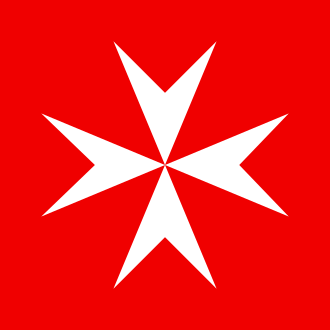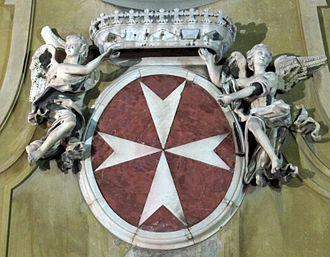Maltese cross






Maltese Cross refers to a cross symbol that consists of four arrowhead-shaped arms converging at a central point. It is a symbol that has been used by various organizations, countries, and entities throughout history, often associated with chivalry, honor, and Christian symbolism. The Maltese Cross is most famously linked to the Knights Hospitaller (also known as the Knights of Malta), an organization that originated during the Crusades in the 11th century. The cross is thus named because of its association with the island of Malta, where the Knights Hospitaller were based from the 16th century until their departure in the late 18th century.
History[edit]
The origins of the Maltese Cross can be traced back to the Crusades, a series of religious and military campaigns in the medieval period aimed at recapturing the Holy Land from Muslim rule. The Knights Hospitaller, a Christian military order, adopted the cross as part of their insignia. It was a symbol that represented their commitment to faith, their mission to provide care for the sick and poor, and their readiness to defend Christianity.
Design[edit]
The design of the Maltese Cross is distinctive, featuring four V-shaped arms that meet at a central point, creating eight points in total. These points are said to represent the eight obligations or aspirations of the knights, including faith, repentance, humility, justice, mercifulness, sincerity, and endurance. The cross is often depicted in a bright red color, symbolizing the knights' willingness to shed blood in defense of their faith.
Modern Usage[edit]
Today, the Maltese Cross is used by various organizations, both secular and religious. It is a common symbol in the fire service, used to represent the principles of courage, valor, and sacrifice. Firefighters wear the Maltese Cross to signify their willingness to lay down their lives for others, drawing a parallel with the knights' commitment to service and protection. Additionally, the cross is used by the Sovereign Military Order of Malta, the modern successor to the Knights Hospitaller, and can be seen in the insignia of various military and civil orders around the world.
Controversies[edit]
While the Maltese Cross is widely regarded as a symbol of service and sacrifice, its use has also been subject to controversy. Some groups have adopted the cross for purposes that are not aligned with its original values of chivalry and charity, leading to debates about the appropriate use and representation of the symbol.
Conclusion[edit]
The Maltese Cross remains a powerful symbol of commitment, sacrifice, and service. Its rich history and distinctive design have made it an enduring emblem for organizations dedicated to helping others and defending principles worth fighting for.
| This article is a stub. You can help WikiMD by registering to expand it. |
Ad. Transform your life with W8MD's Budget GLP-1 injections from $75


W8MD offers a medical weight loss program to lose weight in Philadelphia. Our physician-supervised medical weight loss provides:
- Weight loss injections in NYC (generic and brand names):
- Zepbound / Mounjaro, Wegovy / Ozempic, Saxenda
- Most insurances accepted or discounted self-pay rates. We will obtain insurance prior authorizations if needed.
- Generic GLP1 weight loss injections from $75 for the starting dose.
- Also offer prescription weight loss medications including Phentermine, Qsymia, Diethylpropion, Contrave etc.
NYC weight loss doctor appointmentsNYC weight loss doctor appointments
Start your NYC weight loss journey today at our NYC medical weight loss and Philadelphia medical weight loss clinics.
- Call 718-946-5500 to lose weight in NYC or for medical weight loss in Philadelphia 215-676-2334.
- Tags:NYC medical weight loss, Philadelphia lose weight Zepbound NYC, Budget GLP1 weight loss injections, Wegovy Philadelphia, Wegovy NYC, Philadelphia medical weight loss, Brookly weight loss and Wegovy NYC
|
WikiMD's Wellness Encyclopedia |
| Let Food Be Thy Medicine Medicine Thy Food - Hippocrates |
Medical Disclaimer: WikiMD is not a substitute for professional medical advice. The information on WikiMD is provided as an information resource only, may be incorrect, outdated or misleading, and is not to be used or relied on for any diagnostic or treatment purposes. Please consult your health care provider before making any healthcare decisions or for guidance about a specific medical condition. WikiMD expressly disclaims responsibility, and shall have no liability, for any damages, loss, injury, or liability whatsoever suffered as a result of your reliance on the information contained in this site. By visiting this site you agree to the foregoing terms and conditions, which may from time to time be changed or supplemented by WikiMD. If you do not agree to the foregoing terms and conditions, you should not enter or use this site. See full disclaimer.
Credits:Most images are courtesy of Wikimedia commons, and templates, categories Wikipedia, licensed under CC BY SA or similar.
Translate this page: - East Asian
中文,
日本,
한국어,
South Asian
हिन्दी,
தமிழ்,
తెలుగు,
Urdu,
ಕನ್ನಡ,
Southeast Asian
Indonesian,
Vietnamese,
Thai,
မြန်မာဘာသာ,
বাংলা
European
español,
Deutsch,
français,
Greek,
português do Brasil,
polski,
română,
русский,
Nederlands,
norsk,
svenska,
suomi,
Italian
Middle Eastern & African
عربى,
Turkish,
Persian,
Hebrew,
Afrikaans,
isiZulu,
Kiswahili,
Other
Bulgarian,
Hungarian,
Czech,
Swedish,
മലയാളം,
मराठी,
ਪੰਜਾਬੀ,
ગુજરાતી,
Portuguese,
Ukrainian